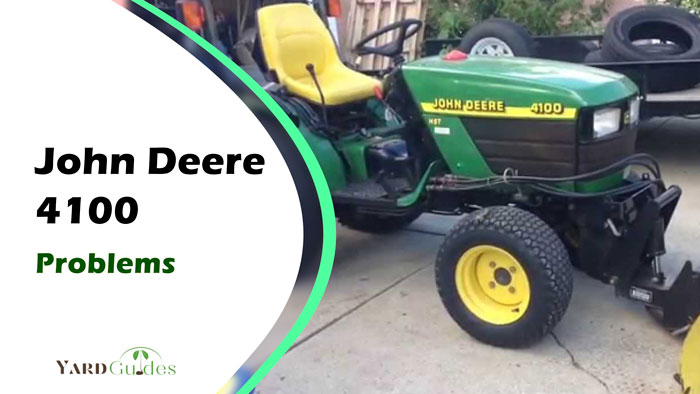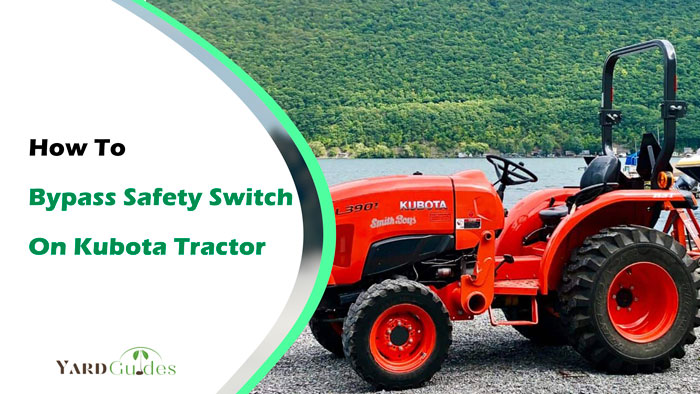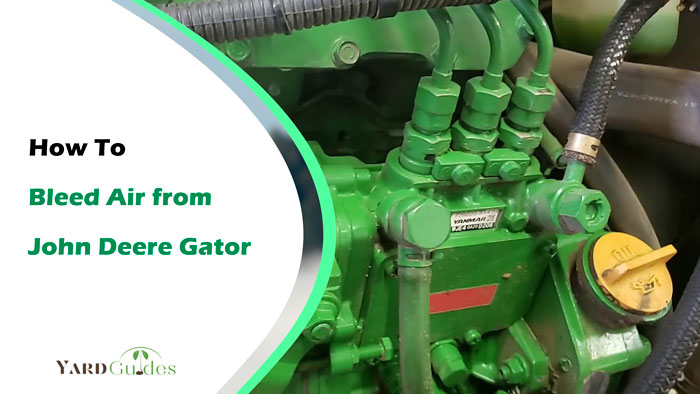John Deere 4100 is a commonly used tractor. But like other tractors and vehicles, it also has some common problems.
So, what are the John Deere 4100 problems? The most common problem is a damaged PTO clutch which causes failure in energy transmission. Also, the engine can have problems or work slowly in starting. You can also face a situation when your tractor gets stuck suddenly, but the engine is working.
That’s not the end. These are only the problems. You can get details about the problems and their solutions in this article.
Problems And Their Quick Solutions For John Deere 4100
The most common problems on John Deere 4100 are given in the table below with their quick solutions.
| Problems | Solutions |
| 1. PTO clutch gets damaged | Replace the wires, switch, fuse, and coat the new wiring |
| 2. The engine works slowly in starting | Flush the fuel and open the blockage Refill the reservoir with clean fuel |
| 3. John Deere is not starting | Remove the corrosion of the battery, and replace the connecting wire, piston and plug if it is not working Make sure the spark plug is functioning properly; Replace the spark plug if it is damaged Do not let the cylinder dry |
| 4. Shaky movement | Replace the pulley and axle |
| 5. Stuck suddenly but the engine is working | Replace the steering pump and cylinder, and place the drive belt in position Refill the transmission fluid |
| 6. Dirty Carburetor | Clean the Carburetor |
John Deere 4100 Problems and Solutions Discussed in Detail
The common problem you can face with your John Deere 4100 is a damaged PTO clutch and starting problem. Also, some other problems can bother you. Let’s discuss 6 common problems and solutions in detail here.
1. PTO Clutch Gets Damaged
The PTO clutch maintains the connection between the engine and the rear part of the tractor. It also helps to transfer energy between these two parts.
But if the clutch gets damaged mainly in the upper part, there will be mismanagement in transferring the energy. The rear part can not perform at all if the supply of energy stops.
However, PTO clutch damage mainly arises when it bears extra load than its capacity frequently. And it results in wire damage or firing. The fuse and switch will get damaged or frequently burn if the PTO clutch has issues.
Solution
The recommended solution here is to replace the damaged PTO clutch. Follow the steps below to do this.
Step 1: First, remove the PTO clutch to detect the problem
Step 2: Disconnect and detach the protection cables by disassembling the guard’s screw
Step 3: After completely detaching, replace the wires and cover it to avoid further damage
Step 4: Reconnect the connections and reassemble the PTO clutch components in place
Step 5: Check the fuse and switch
Step 6: If the switch and fuse are burned, change them
However, replacing the damaged PTO clutch from an auto repair shop is always recommended.
Try to check the fuse and switch regularly to detect PTO clutch-related problems as damage directly hits the fuse and switch. There is no other way to detect PTO clutch-related problems.
2. The Engine Works Slowly In Starting
The engine works slowly and produces comparatively less energy at the start. This occurs when there is a fuel-related problem in the tractor.
If you do not flush for a long time, or if the fuel is contaminated, the engine will not be capable of using the fuel properly to produce energy.
Also, the engine will not get enough fluid if there is any blockage in the fuel transmission path. That will result in the slow working of the engine. Also, a low level of fluid results in this problem.
Solution
If the engine works slowly, flushing and refilling the fuel is the main solution. You can follow the below process to solve it.
Step 1: Check the fuel level
Step 2: Check if it is contaminated or not
Step 3: If contaminated, flush the whole system
Step 4: Find the blockage and open it
Step 5: Fill the reservoir with fuel at the maximum level
Drive in the right way to decrease the fuel consumption rate. Also, check the fuel regularly to avoid this kind of problem.
Problem 3: John Deere Is Not Starting
It is a common problem. Mainly it occurs when there is corrosion in the battery or battery-related part damage. Corrosion mostly occurs in the front part of the battery.
An expired battery also causes this. Also, if the cylinder is dry and you do not boost it for a long time, the engine will not start. Avoiding this problem can permanently damage the battery and engine.
Solution
To fix this problem, you have to check a lot of parts and act accordingly.
- Check the corrosion in the battery and remove it
- Check the connecting wires of the battery. If it gets damaged, replace it
- Make sure the spark plug is functioning properly
- Replace the spark plug if it is damaged, and replace it if it’s been used for more than 100 hrs.
- Check the engine. If it is not supplying proper energy, take help from an expert
- Do not let the cylinder dry
You should check the battery corrosion regularly. And don’t forget to check the expiration date.
Problem 4: Shaky Movement
If the rear axle or the pulley is loose, there will be shaky movement or vibration while starting. The axle can also damage and vibrate the whole tractor.
Solution
Check the axle to see if it is damaged or not. Then follow the steps to take the action.
Step 1: Replace the axle if it’s damaged. But it’s recommended to take the expert’s suggestion as it is complicated to reinstall
Step 2: Check the connection of the bolt in the axle. Tighten them if they are loose
Step 3: Replace the damaged pulley
However, you should not replace these parts yourself if you have less experience.
Problem 5: Stuck Suddenly But The Engine Is Working
Like other vehicles, your John Deere can be stuck anytime when the engine is working well. This problem arises when the transmission fluid level is very low or the belt drive is displaced due to wrong weight distribution. Also, this can happen due to a bad steering cylinder and pump.
Solution
If this problem arises, you should take these actions at once.
- Immediately stop the engine
- Place the drive belt correctly
- Check the transmission fluid level and refill the reservoir
- Replace the bad steering cylinder and steering pump
Problem 6: Dirty Carburetor
A filthy carburetor hinders engine performance. If it is dirty, it cannot measure and control the air and oil ratio properly.
Solution
Follow the steps to clean the dirty carburetor
Step 1: Detach the carburetor from the engine
Step 2: Rub it with a fabric to clean the oil and dirt accumulated in it. You can use a carburetor cleaning additive to clean it and a compressor to eliminate any excess liquid
Step 3: Disconnect the oil filter
Step 4: Clear the blocked fuel line
Step 5: Reconnect the oil filter
Step 6: Reset the carburetor
Step 6: Maintain a clean environment to save your engine from getting clogged or accumulated with dirt again
Conclusion
John Deere 4100 is an affordable tractor that can also face some problems like other vehicles. But you can easily solve these problems by yourself and also in a repair shop at a low cost. Engine problems, transmission problems, and starting problems are common in this tractor.
If you don’t ensure proper maintenance of your tractor regularly, you will face these problems frequently. But if you avoid these little problems, you will face bigger troubles that can cost a lot.



